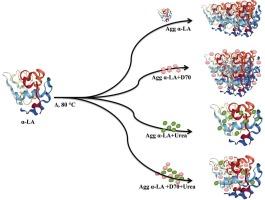用生物物理方法探讨尿素在防止α -乳清蛋白聚集中的作用
IF 5.2
2区 化学
Q2 CHEMISTRY, PHYSICAL
引用次数: 0
摘要
蛋白质聚集是许多神经退行性疾病的共同特征,并提出了生物技术和药物配方的挑战。尿素是一种众所周知的变性剂,因其在蛋白质折叠和展开中的作用而被广泛研究。然而,它在防止蛋白质聚集和减轻大分子拥挤效应方面的潜在作用仍然很少被探索。在这项研究中,我们研究了低浓度尿素在拥挤环境中影响蛋白质聚集的分子机制。利用光谱技术、显微和聚集分析的组合,我们证明尿素调节蛋白质-溶剂相互作用,减少驱动聚集的分子间接触,并减轻拥挤溶液中排除的体积效应。我们的研究结果表明,尿素不仅作为一种化学伴侣,而且在生理相关条件下作为蛋白质溶解度的可调调节剂。这些见解为尿素在蛋白质化学中的多方面作用提供了更深入的理解,并可能对针对蛋白质错误折叠疾病的治疗策略产生影响。本文章由计算机程序翻译,如有差异,请以英文原文为准。

Exploring the role of urea in preventing aggregation in alpha Lactalbumin protein using biophysical approaches
Protein aggregation is a common characteristic of numerous neurodegenerative diseases and presents challenges in biotechnology and pharmaceutical formulations. Urea, a well-known denaturant, has been widely studied for its role in protein folding and unfolding. However, its potential role in preventing protein aggregation and mitigating macromolecular crowding effects remains less explored. In this study, we investigate the molecular mechanisms by which lower concentration of urea influences protein aggregation in crowded environments. Using a combination of spectroscopic techniques, microscopic, and aggregation assays, we demonstrate that urea modulates protein-solvent interactions, reduces intermolecular contacts that drive aggregation, and alleviates excluded volume effects in crowded solutions. Our findings suggest that urea acts not only as a chemical chaperone but also as a tunable modulator of protein solubility in physiologically relevant conditions. These insights provide a deeper understanding of urea's multifaceted role in protein chemistry and may have implications for therapeutic strategies targeting protein misfolding diseases.
求助全文
通过发布文献求助,成功后即可免费获取论文全文。
去求助
来源期刊

Journal of Molecular Liquids
化学-物理:原子、分子和化学物理
CiteScore
10.30
自引率
16.70%
发文量
2597
审稿时长
78 days
期刊介绍:
The journal includes papers in the following areas:
– Simple organic liquids and mixtures
– Ionic liquids
– Surfactant solutions (including micelles and vesicles) and liquid interfaces
– Colloidal solutions and nanoparticles
– Thermotropic and lyotropic liquid crystals
– Ferrofluids
– Water, aqueous solutions and other hydrogen-bonded liquids
– Lubricants, polymer solutions and melts
– Molten metals and salts
– Phase transitions and critical phenomena in liquids and confined fluids
– Self assembly in complex liquids.– Biomolecules in solution
The emphasis is on the molecular (or microscopic) understanding of particular liquids or liquid systems, especially concerning structure, dynamics and intermolecular forces. The experimental techniques used may include:
– Conventional spectroscopy (mid-IR and far-IR, Raman, NMR, etc.)
– Non-linear optics and time resolved spectroscopy (psec, fsec, asec, ISRS, etc.)
– Light scattering (Rayleigh, Brillouin, PCS, etc.)
– Dielectric relaxation
– X-ray and neutron scattering and diffraction.
Experimental studies, computer simulations (MD or MC) and analytical theory will be considered for publication; papers just reporting experimental results that do not contribute to the understanding of the fundamentals of molecular and ionic liquids will not be accepted. Only papers of a non-routine nature and advancing the field will be considered for publication.
 求助内容:
求助内容: 应助结果提醒方式:
应助结果提醒方式:


